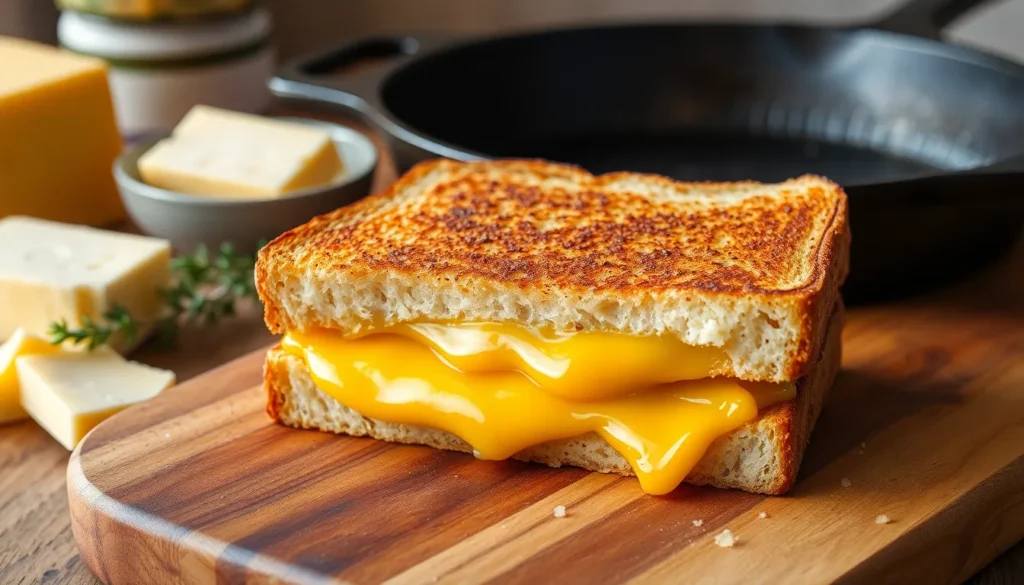Nothing beats the satisfying crunch of perfectly golden bread giving way to molten cheese that stretches endlessly from sandwich to mouth. We’ve all experienced that moment of pure comfort food bliss, and today we’re sharing our foolproof method for creating the ultimate grilled cheese sandwich that’ll make your taste buds dance.
This isn’t just any ordinary grilled cheese recipe – we’ve perfected the technique through countless kitchen experiments to bring you a sandwich with impossibly crispy exteriors and gloriously gooey centers. Whether you’re feeding hungry kids after school or treating yourself to a nostalgic comfort meal, mastering this classic will elevate your sandwich game forever.
Our step-by-step guide eliminates all the guesswork and common pitfalls that lead to burnt bread or unmelted cheese. You’ll discover the secret temperature settings, ideal cheese combinations, and pro tips that transform this simple dish into restaurant-quality perfection every single time.
Ingredients
Creating our perfect grilled cheese sandwich requires carefully selected ingredients that work together to achieve that ideal balance of crispy exterior and gooey interior. We’ve tested countless combinations to bring you this foolproof ingredient list.
For the Sandwich:
- 8 slices of thick-cut white bread (about ¾-inch thick)
- 8 ounces sharp cheddar cheese, freshly grated
- 4 ounces Gruyère cheese, freshly grated
- 4 tablespoons unsalted butter, softened to room temperature
- 2 tablespoons mayonnaise
- ¼ teaspoon garlic powder
- Pinch of salt
Optional Flavor Enhancers:
- 1 tablespoon Dijon mustard
- 2 tablespoons caramelized onions
- 4 strips crispy bacon
- 2 medium tomato slices, patted dry
- Fresh thyme leaves
Our ingredient selection focuses on quality over quantity. We recommend using thick-cut bread because thin slices become soggy before the cheese properly melts. The combination of sharp cheddar and Gruyère creates depth of flavor while ensuring smooth melting properties.
Room temperature butter spreads easily without tearing the bread surface. We add mayonnaise to our butter mixture because it contains proteins that brown beautifully and create an extra crispy crust. Freshly grated cheese melts more evenly than pre-shredded varieties since it lacks anti-caking agents that can prevent smooth melting.
Equipment Needed
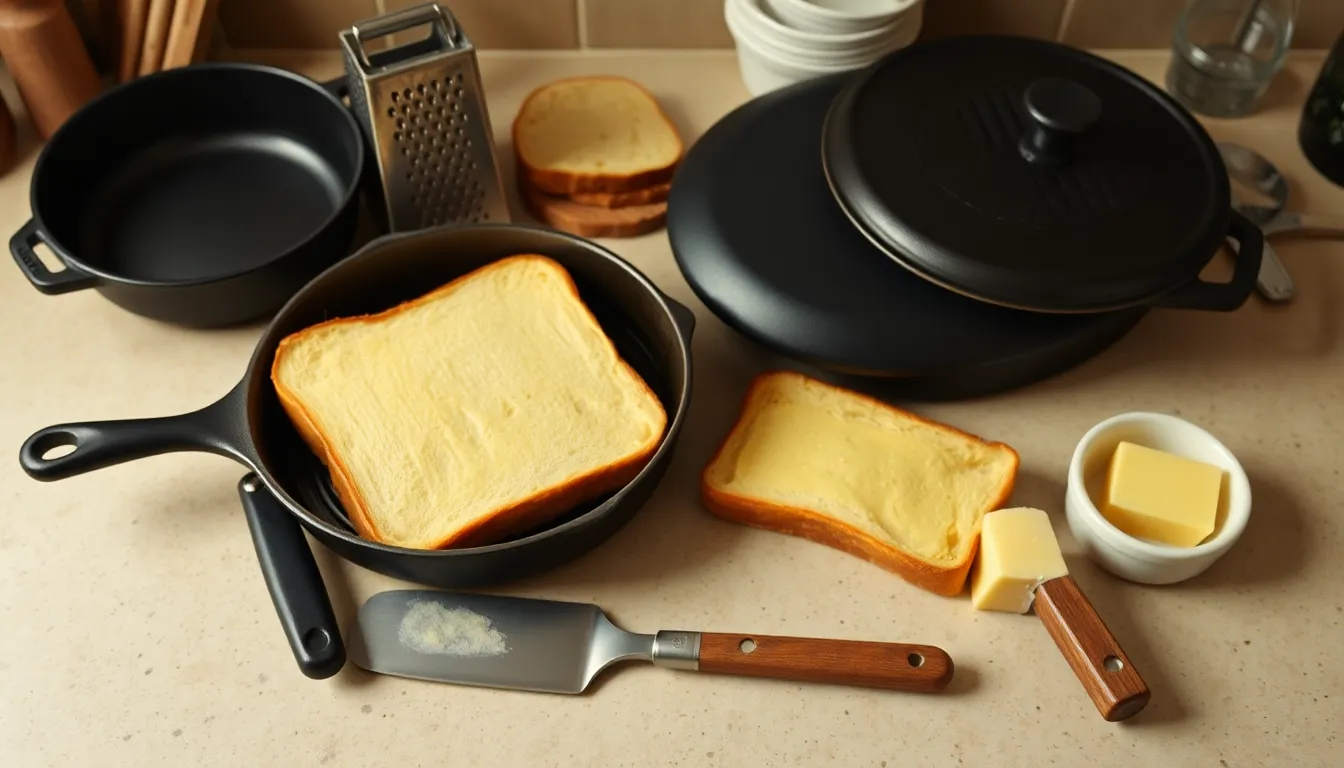
Creating the perfect grilled cheese sandwich requires the right tools to achieve that crispy exterior and gooey melted center we’re aiming for in this recipe.
Cast iron skillet takes priority in our kitchen setup. We prefer cast iron over other cookware because it delivers superior browning and maintains consistent heat distribution throughout the cooking process. A nonstick pan works as an alternative but requires more careful heat control to prevent sticking.
Sharp bread knife becomes essential when working with artisan loaves or unsliced bread. We need clean, even slices to create uniform sandwiches that cook evenly on both sides.
Cheese grater ensures optimal melting results. We always grate our cheese fresh rather than using pre-shredded varieties because grated cheese melts more uniformly than thick slices.
Wide spatula provides the control we need for clean flipping without breaking our sandwich. We recommend a thin, flexible spatula that slides easily under the bread without disturbing the melted cheese.
Skillet lid serves a crucial function in our cooking method. We cover the sandwich during cooking to trap steam, which helps melt the cheese thoroughly while the bread develops its golden crust.
| Equipment | Purpose | Alternative |
|---|---|---|
| Cast iron skillet | Superior browning and heat retention | Nonstick pan |
| Sharp bread knife | Even slicing of bread | Pre-sliced bread |
| Cheese grater | Uniform cheese melting | Pre-grated cheese |
| Wide spatula | Clean sandwich flipping | Regular spatula |
| Skillet lid | Steam trapping for cheese melting | Aluminum foil |
Butter spreader or small offset spatula helps us apply mayonnaise evenly across the bread surface. This tool ensures complete coverage for consistent browning across the entire sandwich exterior.
Small bowl keeps our butter and mayonnaise mixture ready for application. We find mixing these ingredients beforehand streamlines our cooking process and prevents uneven distribution.
Instructions
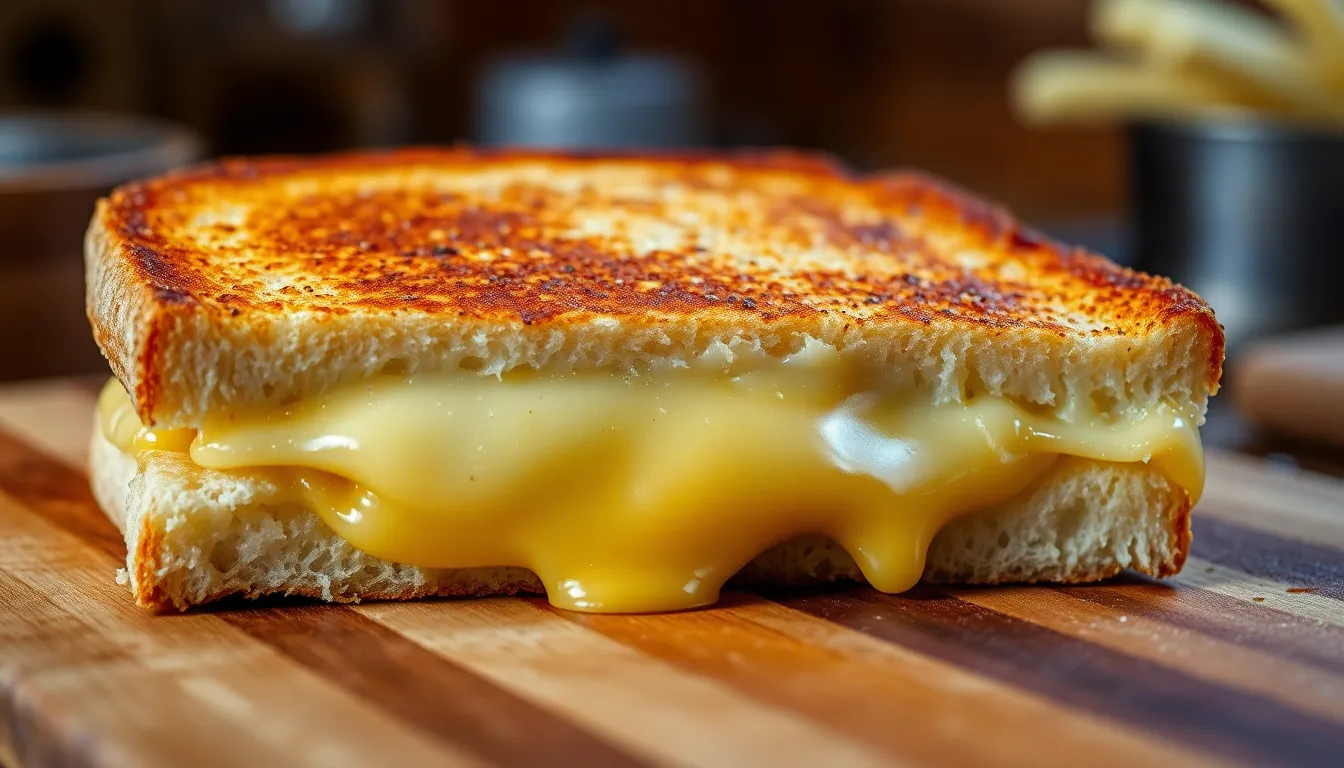
We’ve refined our technique through countless kitchen experiments to bring you this foolproof method. Follow these steps carefully to achieve the perfect balance of crispy exterior and melted cheese interior.
Prep the Bread and Cheese
We start by gathering our thick-cut white bread slices and ensuring they’re at room temperature for even cooking. Cut each slice to approximately 1/2 inch thickness to prevent sogginess while maintaining structural integrity. Grate both the sharp cheddar and Gruyère cheeses using a box grater or food processor to ensure smooth melting. Freshly grated cheese melts far more evenly than pre-shredded varieties since anti-caking agents in packaged cheese impair melt quality. We recommend grating about 1/2 cup of each cheese type per sandwich for optimal coverage.
Butter the Bread
We combine the softened unsalted butter with mayonnaise in our small mixing bowl until smooth and creamy. This mixture creates an exceptionally crispy crust while adding rich flavor depth. Spread this butter-mayo blend generously on one side of each bread slice using our butter spreader. The coating should cover the entire surface from edge to edge to ensure even browning. We apply the mixture to what will become the exterior surfaces of our sandwich.
Assemble the Sandwich
We place one slice of bread butter-side down in our preheated cast iron skillet over medium-low heat. Sprinkle a light dusting of garlic powder and salt across the bread surface for added flavor. Layer the grated sharp cheddar evenly across the bread followed by the Gruyère cheese. Add any optional ingredients like Dijon mustard or caramelized onions at this stage. Top with the second bread slice butter-side up and press down gently to help bind the layers together.
Cook the Sandwich
We cover the skillet with our lid to trap heat and steam which helps melt the cheese thoroughly while toasting the bread. Cook for 2 to 3 minutes until the bottom develops a golden brown color. Flip the sandwich carefully using our wide spatula and cover again immediately. The second side requires another 2 to 3 minutes of cooking time. We maintain medium-low heat throughout to prevent burning the bread before the cheese melts completely.
Check for Doneness
We look for evenly golden brown bread on both sides with a crisp texture that yields slightly when pressed. The cheese should be fully melted and beginning to bubble around the edges of the sandwich. Lift one corner gently with the spatula to check the bottom browning. The sandwich is ready when both sides achieve a deep golden color and the cheese feels completely molten when we press the center lightly. Remove from heat immediately once these visual and textural cues are met.
Pro Tips for Perfect Grilled Cheese
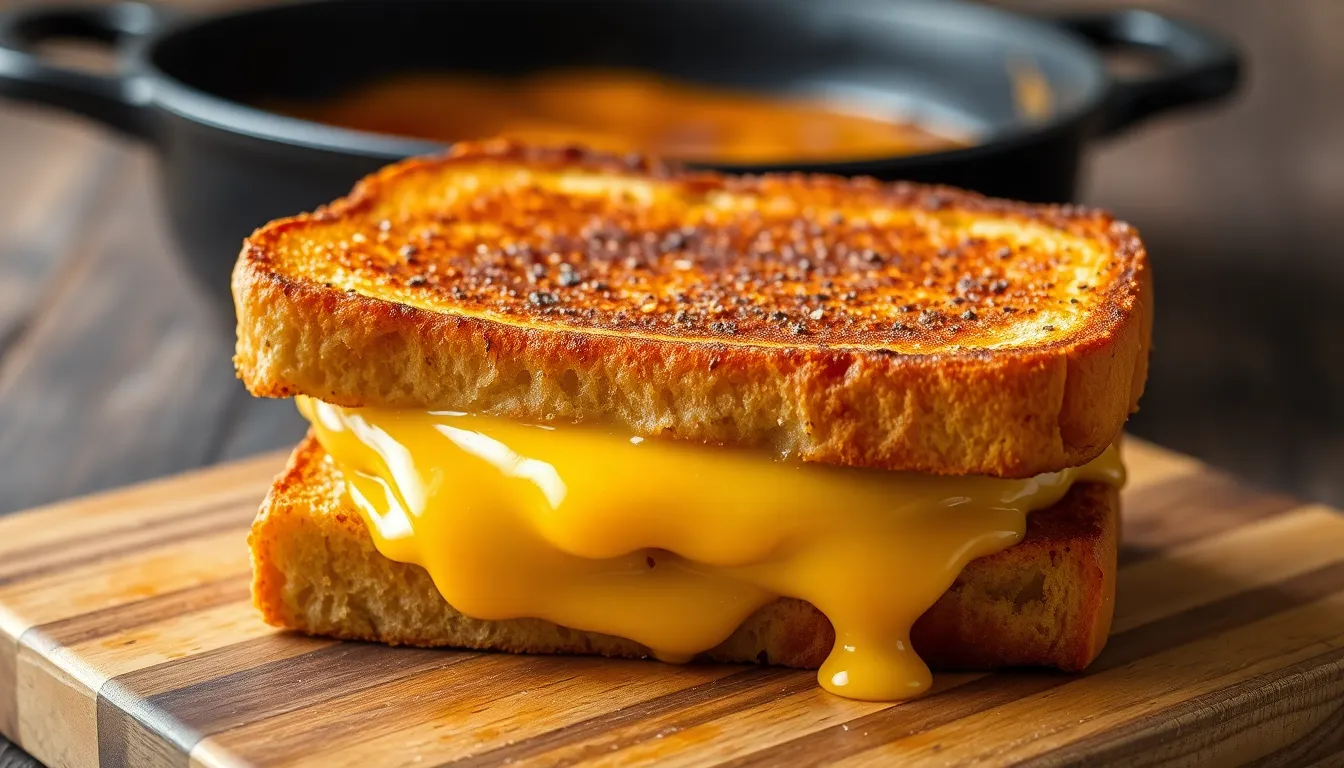
Mastering the perfect grilled cheese requires attention to key details that transform a simple sandwich into a golden masterpiece. We’ve discovered exact techniques that ensure consistent results every time.
Choosing the Right Bread
Selecting the proper bread foundation determines your sandwich’s structural integrity and flavor profile. We recommend avoiding bread that’s too thick, thin, soft, or full of holes to prevent cheese leaking and uneven melting. Sourdough bread delivers exceptional flavor and texture, though you should steer clear of overly hard crusts that resist proper toasting.
Texas toast and thick sliced sandwich bread provide excellent alternatives when sourdough isn’t available. Regular sandwich bread works well for classic preparations, offering reliable results without overwhelming the cheese flavors. The key lies in choosing bread that maintains its shape while allowing heat to penetrate evenly throughout the cooking process.
Best Cheese Combinations
Strategic cheese selection elevates your grilled cheese from ordinary to extraordinary. We achieve optimal results by combining mozzarella for melt and stretchiness with flavorful varieties like sharp cheddar or Gruyère. This pairing delivers both the satisfying cheese pull and robust taste that makes each bite memorable.
Grating your own cheese instead of using pre-grated varieties ensures better melting and smoother texture. Quality cheese slices often prove superior to shredded packets for consistent melting performance. Medium cheddar, Gouda, and Havarti create an exceptional three-cheese blend that balances mild creaminess with rich flavor depth.
Additional winning combinations include Monterey Jack with Swiss, or Colby paired with sharp cheddar. Adventurous cooks can incorporate strong cheeses like blue cheese or brie for gourmet variations that surprise and delight.
Temperature Control
Precise heat management separates amateur attempts from professional results. We cook our grilled cheese on medium to medium-low heat, allowing the bread to toast slowly while cheese melts completely without burning the exterior. This patient approach prevents the common mistake of charred bread surrounding cold, unmelted cheese.
Buttering both sides of the bread ensures even crispiness and enhanced flavor throughout. A cast iron skillet or heavy non-stick pan heated to approximately 275°F provides ideal conditions for controlled browning. Avoiding high heat prevents burning while ensuring thorough cheese melting inside.
Total cooking time should span 5-6 minutes, allowing sufficient time for cheese to melt fully and bread to develop that perfect golden brown color. Light pressing helps the bread stick to the melted cheese, creating better structural integrity for serving.
Variations and Add-Ins
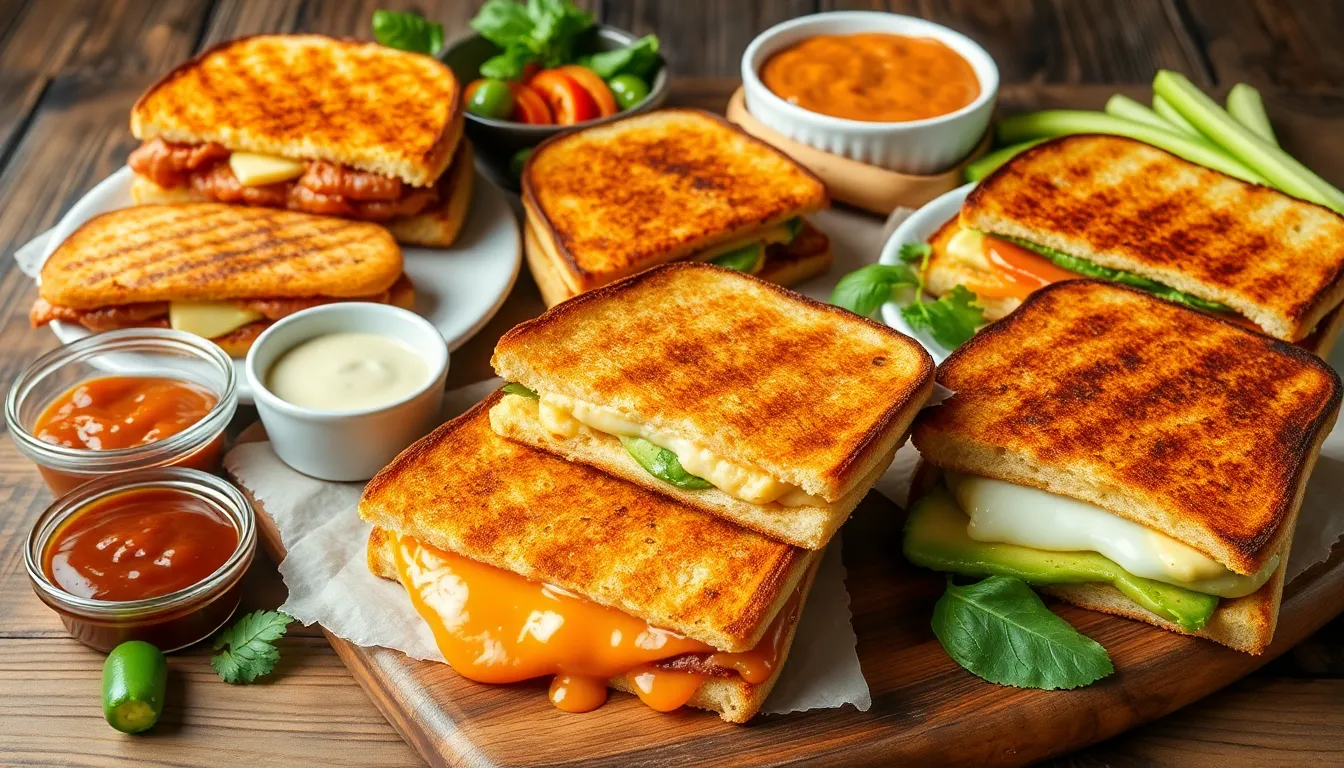
We love experimenting with different ingredients to transform our classic grilled cheese into exciting new flavor combinations. These variations allow you to customize your sandwich based on your preferences and available ingredients.
Gourmet Grilled Cheese Options
Italian Style Grilled Cheese brings the flavors of a classic deli sandwich to your kitchen. We layer provolone cheese with thin slices of salami and pepperoni between our buttered bread. The combination creates a rich, savory experience that rivals any Italian restaurant.
Buffalo Chicken Grilled Cheese transforms leftover buffalo chicken into a hearty meal perfect for lunch or dinner. We combine shredded buffalo chicken with Monterey Jack cheese and blue cheese crumbles on jalapeño bread. The spicy kick from the jalapeño bread complements the tangy buffalo sauce beautifully.
Green Goddess Grilled Cheese offers a fresh, herbaceous twist on the classic recipe. We spread green goddess dressing on our bread before adding mozzarella cheese, fresh spinach leaves, sliced avocado, and tender asparagus spears. This variation provides a lighter, more nutritious option without sacrificing flavor.
Pizza Grilled Cheese captures all the flavors of your favorite pizza in sandwich form. We spread marinara sauce on one slice of bread, add mozzarella cheese, pepperoni slices, and fresh basil leaves. The result tastes like a crispy pizza with every bite.
Garlic Butter Enhancement elevates any grilled cheese variation with aromatic flavor. We mix softened butter with freshly minced garlic before spreading it on our bread. This simple addition creates a restaurant quality taste that makes every sandwich special.
Kid-Friendly Variations
Grilled Cheese Roll Ups make eating fun and easy for little hands. We flatten our bread slices with a rolling pin, add cheese, and roll them up tightly before grilling. These bite sized portions are perfect for dipping in tomato soup and create an interactive eating experience.
Mild Cheese Combinations appeal to young palates while providing familiar flavors. We use mild cheddar, American cheese, or mozzarella as our base since these varieties melt smoothly without overwhelming taste. These gentle flavors help introduce children to the joys of grilled cheese.
Protein Additions boost nutrition without adding strong flavors that might deter picky eaters. We add thin slices of cooked ham or turkey to our sandwiches. These mild meats provide extra protein while maintaining the comfort food appeal kids love.
Sweet Touch Variations satisfy children who enjoy subtle sweetness in their meals. We spread a thin layer of strawberry jam or add crisp apple slices to our cheese sandwich. These additions create a pleasant sweet and savory balance that makes grilled cheese feel like a special treat.
Serving Suggestions
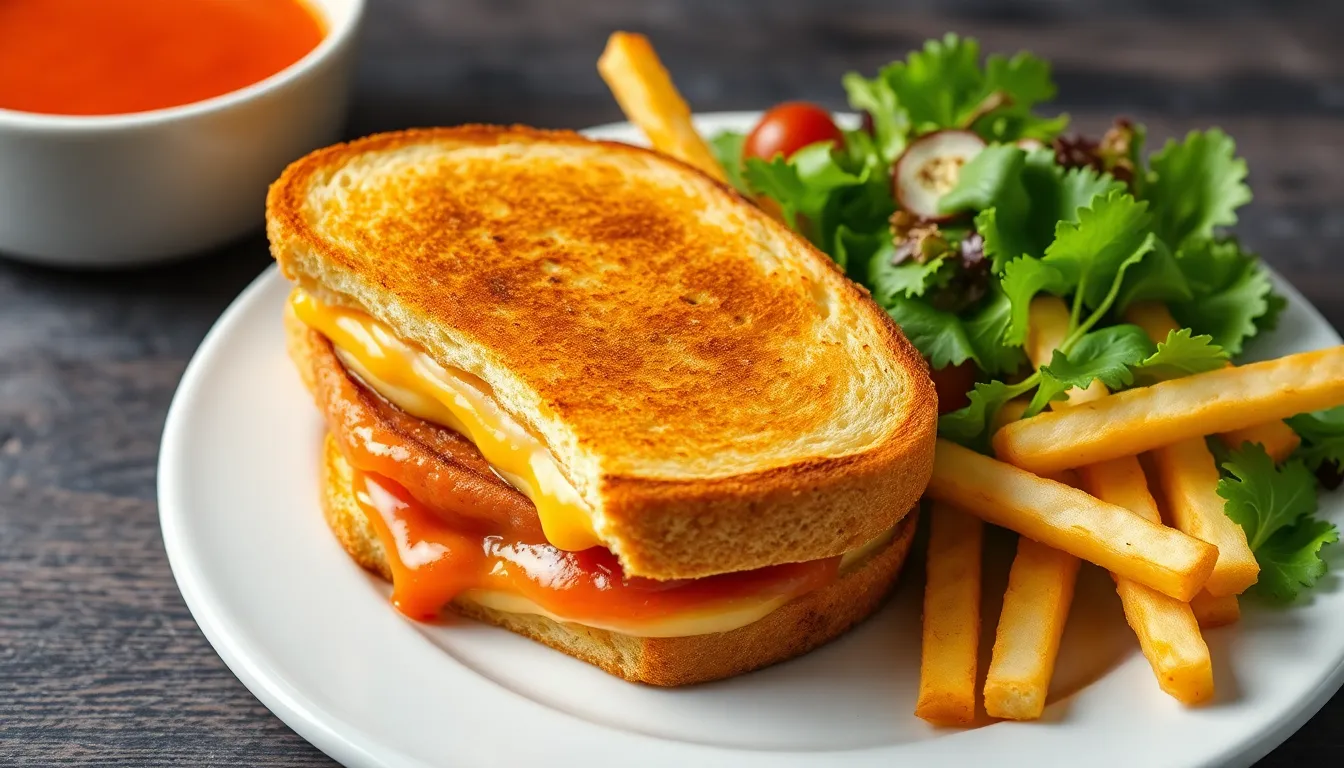
We believe that pairing your perfectly crafted grilled cheese sandwich with the right accompaniments transforms a simple meal into a memorable dining experience. Our testing has shown that complementary sides enhance both the flavor and satisfaction of this classic comfort food.
Classic Soup Pairings
Tomato soup remains the most popular and traditional pairing for grilled cheese sandwiches. The creamy texture and tangy flavor profile creates a perfect balance with the rich cheese and crispy bread. We recommend serving the soup piping hot alongside your sandwich for the ultimate dipping experience.
Crispy Side Options
French fries offer an excellent textural contrast to the soft interior of your grilled cheese. Sweet potato fries provide a slightly healthier alternative while maintaining that satisfying crunch. Tater tots also work wonderfully as a playful addition that both adults and children enjoy.
Fresh and Light Accompaniments
A crisp garden salad helps cut through the richness of the melted cheese and butter. We suggest using mixed greens with a light vinaigrette to maintain balance without overwhelming the sandwich flavors. Vegetable sticks such as carrots, celery, or bell peppers add freshness and crunch to your plate.
Flavorful Dips and Condiments
| Dip Type | Flavor Profile | Best Cheese Pairing |
|---|---|---|
| Marinara sauce | Tangy and herby | Sharp cheddar |
| Tomato jam | Sweet and savory | Gruyère |
| Ketchup | Classic and familiar | American cheese |
Traditional Pickle Pairings
Pickles serve as the perfect acidic counterpoint to rich grilled cheese. Dill pickles offer a classic sharp flavor while bread and butter pickles provide a sweeter option. Coleslaw delivers both crunch and tang in a single side dish.
We find that mixing different textures and temperature contrasts creates the most satisfying meal. The combination of warm, gooey cheese with cool, crisp accompaniments provides sensory variety that keeps each bite interesting.
Storage and Reheating Instructions

We know the magic of a perfect grilled cheese sandwich lies in enjoying it fresh from the skillet when the bread crackles with crispness and the cheese stretches gloriously with each bite. But, life sometimes calls for practical storage answers when we’ve made extra sandwiches or need to save leftovers for later enjoyment.
Proper Storage Guidelines
Our grilled cheese sandwiches maintain their best quality when stored correctly in the refrigerator. We recommend placing cooled sandwiches in an airtight container where they’ll stay fresh for up to 3 days. The key here is allowing the sandwich to cool completely before refrigeration to prevent condensation from creating soggy bread.
For longer storage periods, we can freeze these sandwiches for up to 3 months using airtight packaging or freezer bags. This method works particularly well when we want to meal prep or save sandwiches for busy weeknights.
| Storage Method | Duration | Container Type |
|---|---|---|
| Refrigerator | 3 days | Airtight container |
| Freezer | 3 months | Airtight packaging/freezer bags |
Effective Reheating Techniques
We’ve found that proper reheating makes all the difference in restoring that coveted crispy exterior and melty interior. Frozen sandwiches should first thaw completely in the refrigerator before reheating to ensure even warming throughout.
Our preferred reheating method involves using either the stovetop or oven to restore the bread’s crispness. We heat a skillet over medium low heat and warm each side for 2 to 3 minutes until the bread regains its golden color and the cheese melts perfectly inside.
Oven reheating works exceptionally well too. We preheat the oven to 350°F and place the sandwich on a baking sheet for 5 to 7 minutes, flipping halfway through for even heating.
We strongly advise against microwaving as this method creates soggy bread that loses the textural contrast we worked so hard to achieve. The microwave steams the bread rather than crisping it, resulting in a disappointing eating experience that doesn’t showcase our carefully crafted sandwich.
Conclusion
There’s something truly magical about mastering the art of the perfect grilled cheese sandwich. We’ve shared our tried-and-tested method that transforms simple ingredients into a golden crispy masterpiece with that irresistible gooey center we all crave.
The beauty of this recipe lies in its versatility. Whether you’re sticking to the classic combination or experimenting with our gourmet variations we’ve created a foundation that works every time. From busy weeknight dinners to weekend comfort food sessions this sandwich delivers.
Remember that the secret ingredients are patience and attention to detail. We’ve given you all the tools and techniques needed to avoid common pitfalls and achieve restaurant-quality results right in your own kitchen.
Now it’s time to fire up that skillet and create your own perfect grilled cheese experience. We’re confident you’ll love the results as much as we do!
Frequently Asked Questions
What type of bread works best for grilled cheese sandwiches?
Thick-cut white bread is recommended for the perfect grilled cheese. The thickness prevents sogginess and provides a sturdy base that won’t fall apart during cooking. The bread should be at room temperature before cooking to ensure even browning and proper texture throughout the sandwich.
Which cheese combination creates the best melted center?
Sharp cheddar and Gruyère cheese make an ideal combination for grilled cheese. Sharp cheddar provides bold flavor while Gruyère adds creaminess and superior melting properties. Always use freshly grated cheese rather than pre-shredded, as it melts more evenly and creates that perfect gooey center.
Why should I add mayonnaise to my grilled cheese sandwich?
Mayonnaise mixed with butter creates an extra crispy, golden-brown crust on your grilled cheese. The mayonnaise helps achieve restaurant-quality browning while the butter adds rich flavor. This combination spreads easily and ensures even coverage for consistent results across the entire sandwich surface.
What temperature should I use when cooking grilled cheese?
Cook grilled cheese on medium-low heat for the best results. This temperature allows the bread to brown gradually while giving the cheese enough time to melt completely. High heat will burn the bread before the cheese melts, while too low heat won’t achieve the desired crispy exterior.
How do I know when my grilled cheese is perfectly cooked?
Your grilled cheese is ready when the bread is golden brown and crispy, and the cheese is fully melted throughout. You can gently press the sandwich to check if the cheese feels gooey inside. The exterior should have an even golden color with no pale or burnt spots.
Can I make grilled cheese sandwiches ahead of time?
Yes, you can store cooked grilled cheese sandwiches in the refrigerator for up to 3 days or freeze them for up to 3 months. Store them in airtight containers once completely cooled. For best results, reheat using a stovetop or oven to restore crispness rather than microwaving.
What equipment do I need for the perfect grilled cheese?
Essential equipment includes a cast iron skillet for superior browning, a sharp bread knife for even slicing, a cheese grater for optimal melting, and a wide spatula for clean flipping. A skillet lid helps trap steam for thorough cheese melting, while a butter spreader ensures even coating.
What are the best side dishes to serve with grilled cheese?
Classic pairings include tomato soup, which complements the sandwich’s richness perfectly. Crispy sides like French fries or sweet potato fries add textural contrast, while fresh garden salads provide a light balance. Pickles and various dips also make excellent accompaniments for a complete meal experience.
How can I make grilled cheese more appealing to kids?
Try making Grilled Cheese Roll Ups by flattening the bread and rolling it with mild cheese inside. Use milder cheese combinations like American or mild cheddar, and consider adding fun ingredients like bacon or ham. Cut the sandwiches into fun shapes or strips for easier handling.
Can I add other ingredients to my grilled cheese sandwich?
Absolutely! Popular additions include crispy bacon, caramelized onions, tomato slices, and fresh thyme. For gourmet variations, try combinations like Buffalo chicken, Italian-style with basil and tomato, or even pizza-inspired versions with pepperoni and marinara sauce for unique flavor profiles.

